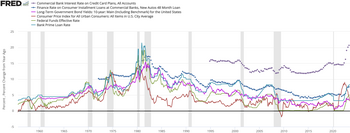Prime rate

The prime rate or prime lending rate is an interest rate used by banks, typically representing the rate at which they lend to their most creditworthy customers. Some variable interest rates may be expressed as a percentage above or below prime rate.[1]: 8
Use in different banking systems
[edit]United States and Canada
[edit]
Historically, in North American banking, the prime rate represented actual interest rate charged to borrowers, although this is no longer universally true. The prime rate varies little among banks and adjustments are generally made by banks at the same time, although this does not happen frequently. As of 26 December 2023[update] the prime rate was 8.50% in the United States[2] and 7.20% in Canada.[3]
In the United States, the prime rate runs approximately 300 basis points (or 3 percentage points) above the federal funds rate, which is the interest rate that banks charge each other for overnight loans made to fulfill reserve funding requirements. The federal funds rate plus a much smaller increment is frequently used for lending to the most creditworthy borrowers, as is LIBOR, the London Interbank Offered Rate. The Federal Open Market Committee (FOMC) meets eight times per year to set a target for the federal funds rate.
Prior to December 17, 2008, the Wall Street Journal followed a policy of changing its published prime rate when 23 out of 30 of the United States' largest banks changed their prime rates. Recognizing that fewer, larger banks now control most banking assets (that is, it is more concentrated), the Journal now publishes a rate reflecting the base rate posted by at least 70% of the top ten banks by assets.
Malaysia
[edit]Effective January 2, 2015, the Base Lending Rate (BLR) structure was replaced with a new Base Rate (BR) system. Under the BR system, which serves as the main reference rate for new retail floating rate loans, Malaysian banks can determine their interest rate based on a formula set by Bank Negara, Malaysia's central bank.[4]
Malayan Banking Bhd (Maybank) has set a group-wide base rate at 3.2%, effective Jan 2, 2015. All new retail loans and financing such as mortgages, unit trust loans, share margin financing, personal financing and overdraft facilities which are applied for by individual customers will be based on the base rate.[5] Though certain banks may be setting a higher BR compared to others, they can sometimes offer lower ELR to customers in order to remain competitive.[6] Loans approved and extended before January 2, 2015 continue to follow the old BLR until the end of their loan tenure.
Uses
[edit]The prime rate is used often as an index in calculating rate changes to adjustable-rate mortgages (ARM) and other variable rate short-term loans. It is used in the calculation of some private student loans. Many credit cards and home equity lines of credit with variable interest rates have their rate specified as the prime rate (index) plus a fixed value commonly called the spread or margin.
See also
[edit]References
[edit]- ^ Thomas, L., Money, Banking and Financial Markets (Mason, OH: Thomson South-Western, 2006), p. 8.
- ^ According to data published by The Wall Street Journal Online and the Federal Reserve Board of Governors. "Federal Reserve Statistical Data". Federal Reserve.
- ^ According to data published by The Wall Street Journal Online and the Bank of Canada. "Daily Digest- Rates and Statistics- Bank of Canada". Bank of Canada.
- ^ Ho, Fiona (January 6, 2015). "Base Rate vs BLR in Malaysia: How Does BR Work?". iMoney.my. Retrieved January 26, 2015.
- ^ "Maybank sets base rate at 3.2%". The Sun Daily. January 5, 2015. Retrieved January 26, 2015.
- ^ Ho, Fiona (January 6, 2015). "Base Rate vs BLR in Malaysia: How Does BR Work?". iMoney.my. Retrieved January 26, 2015.
